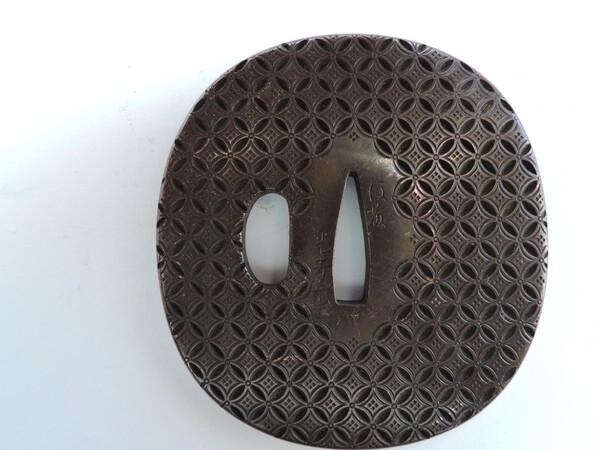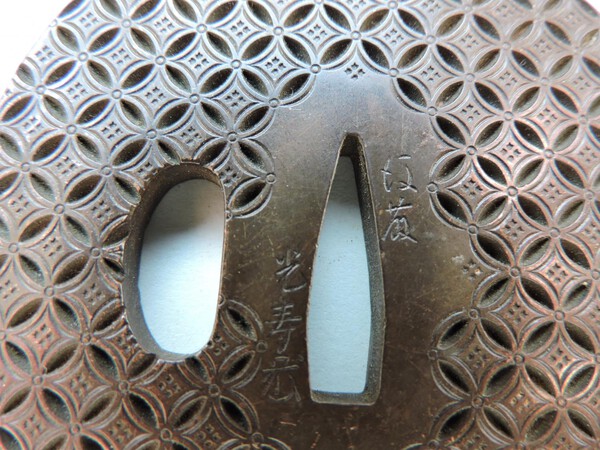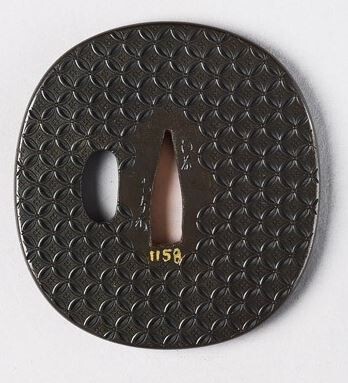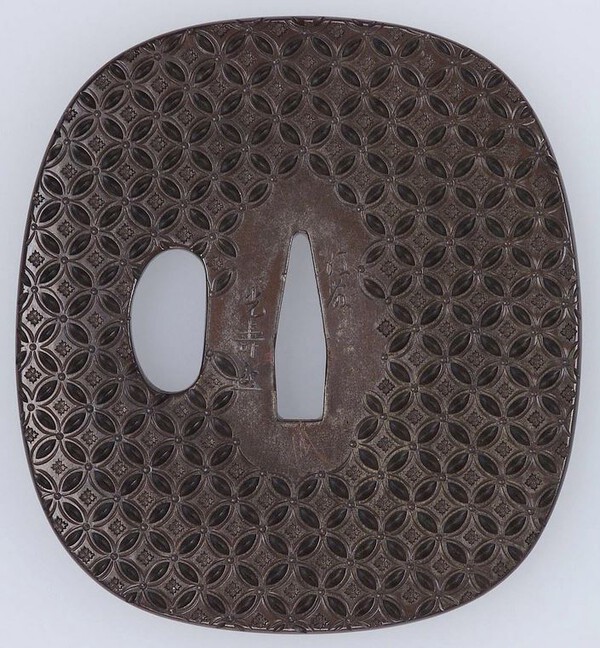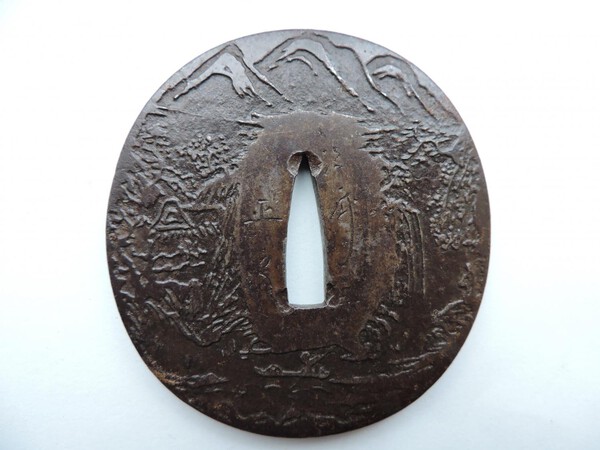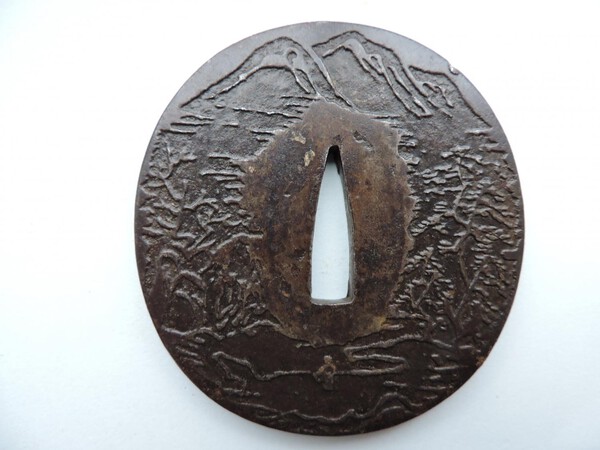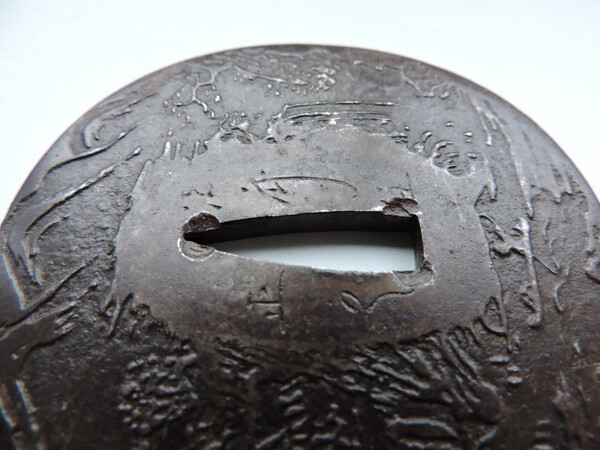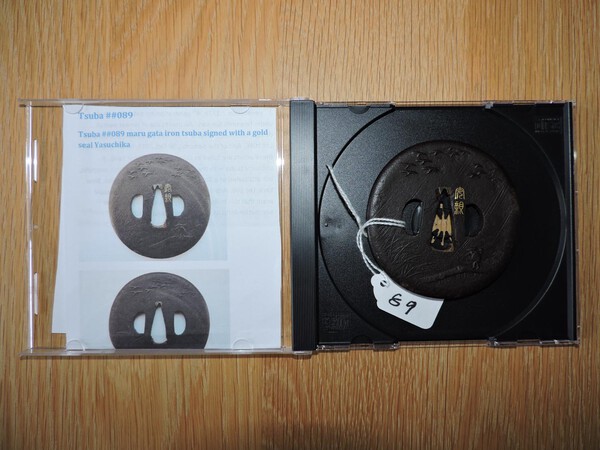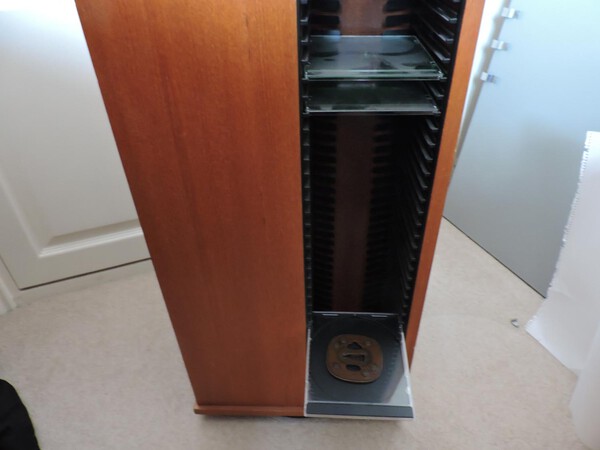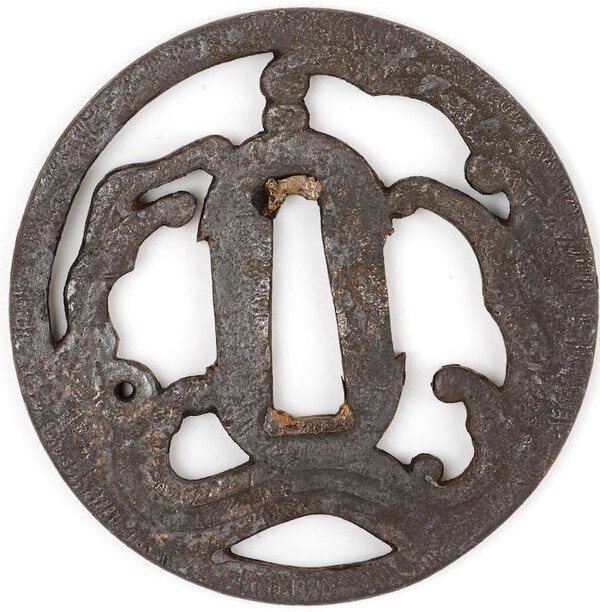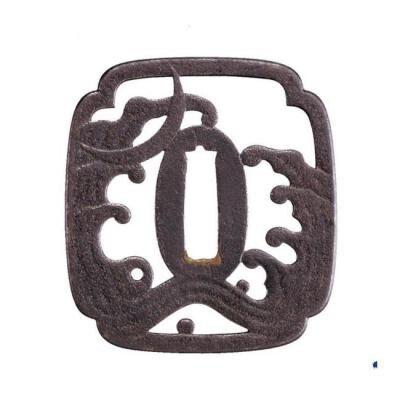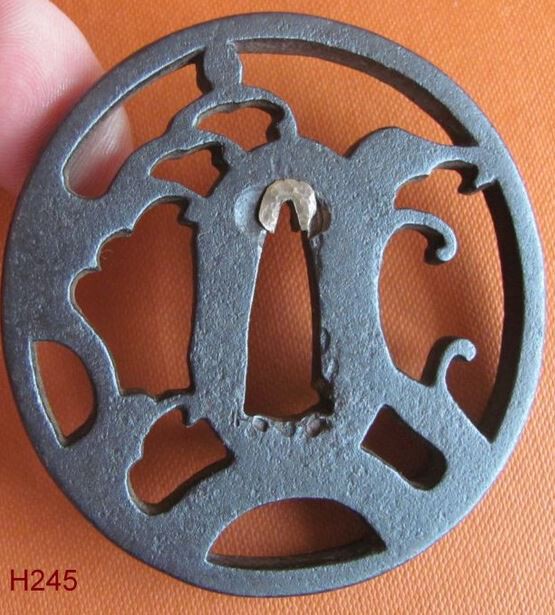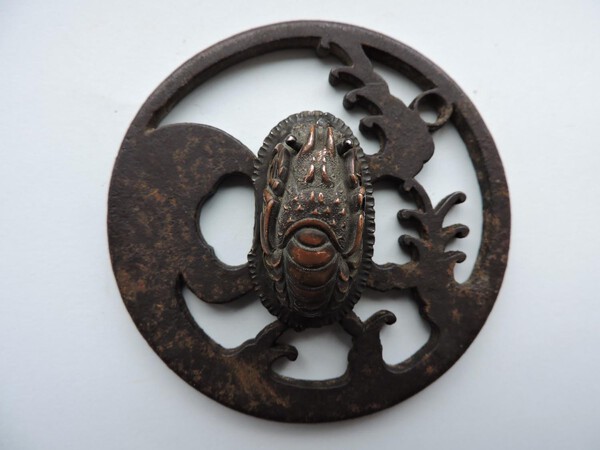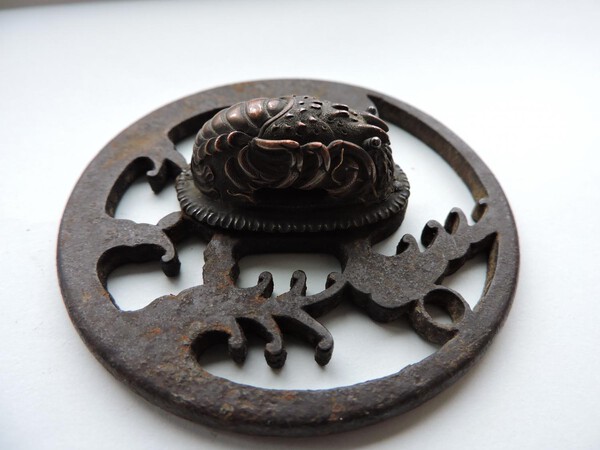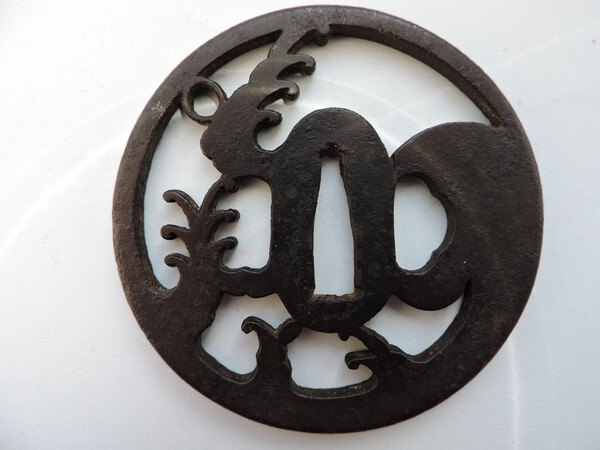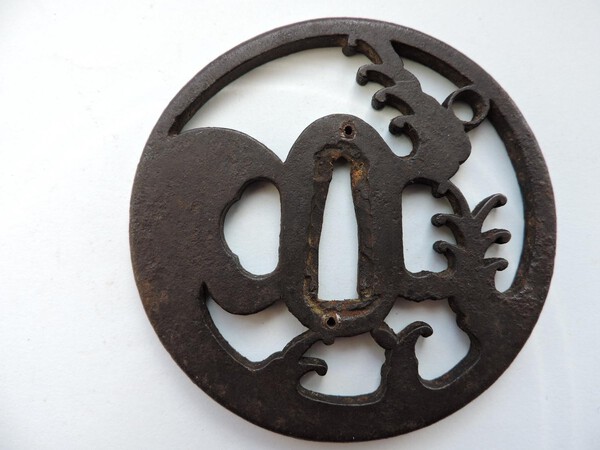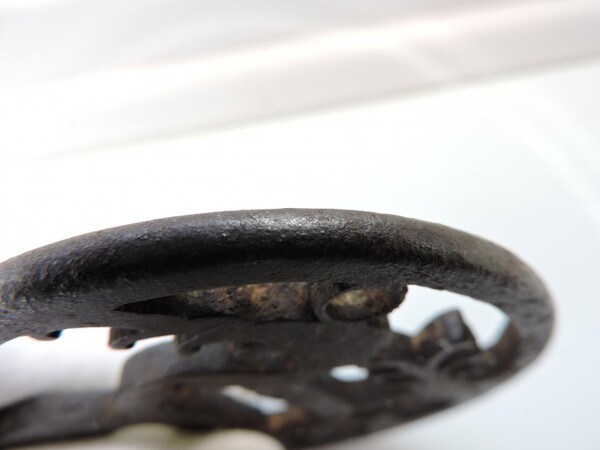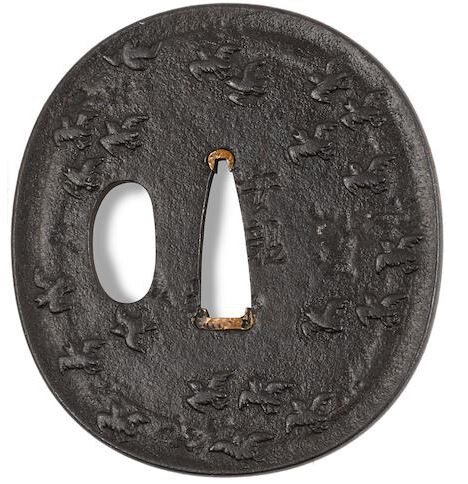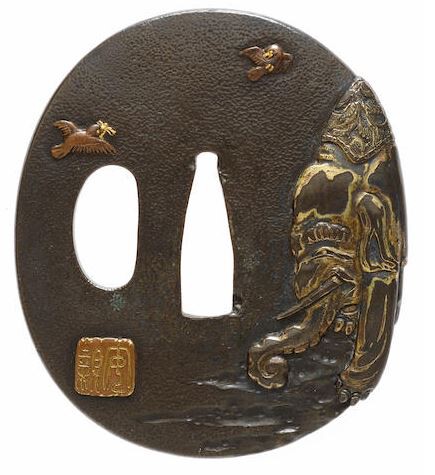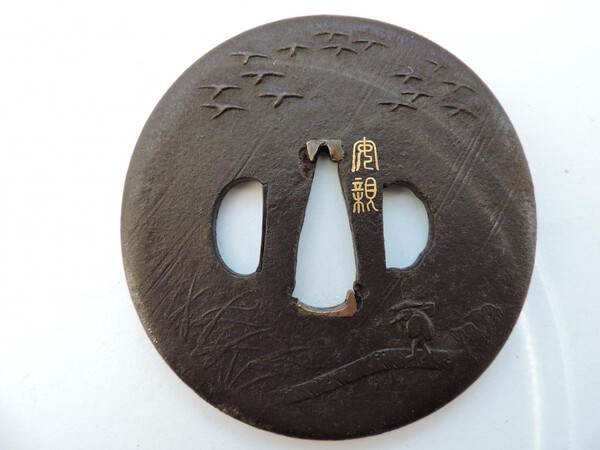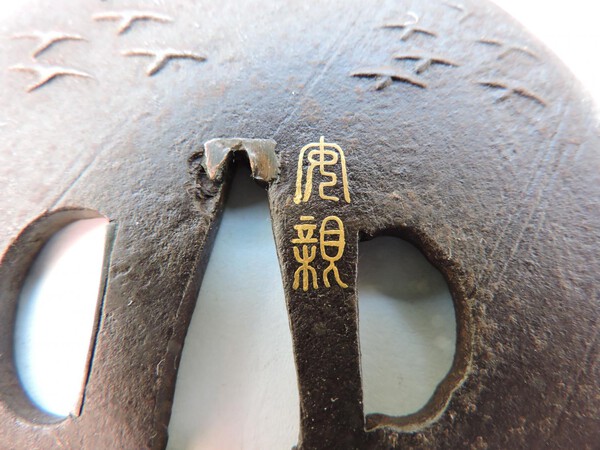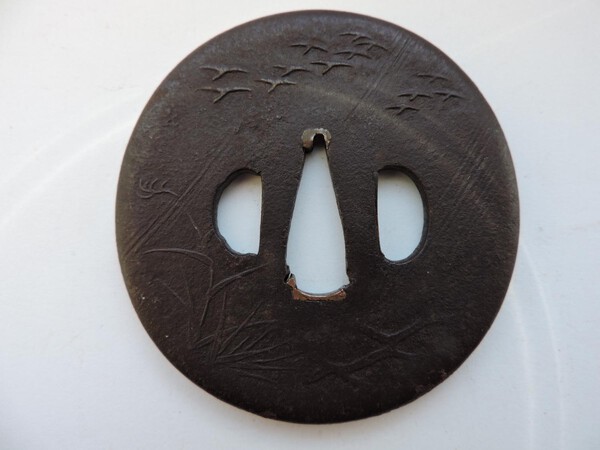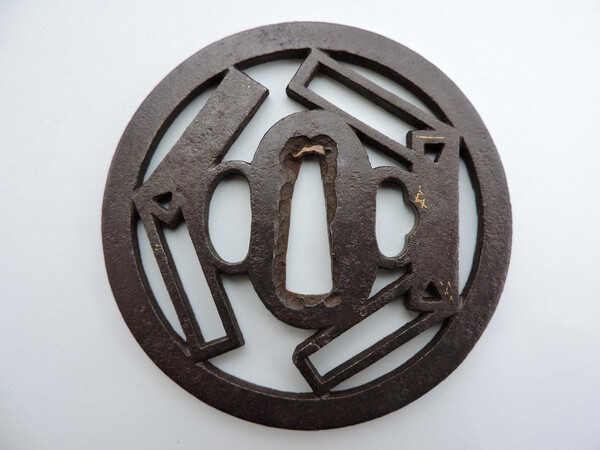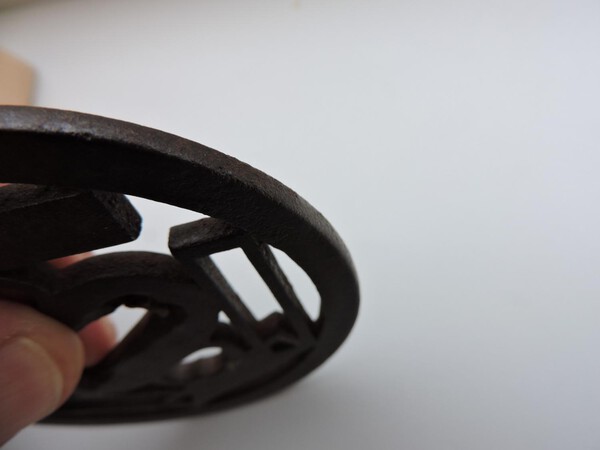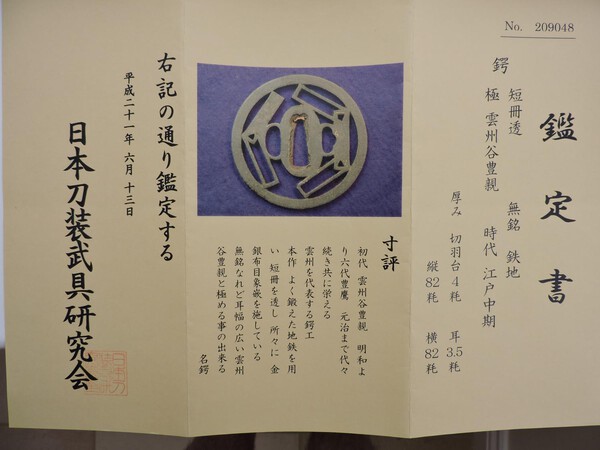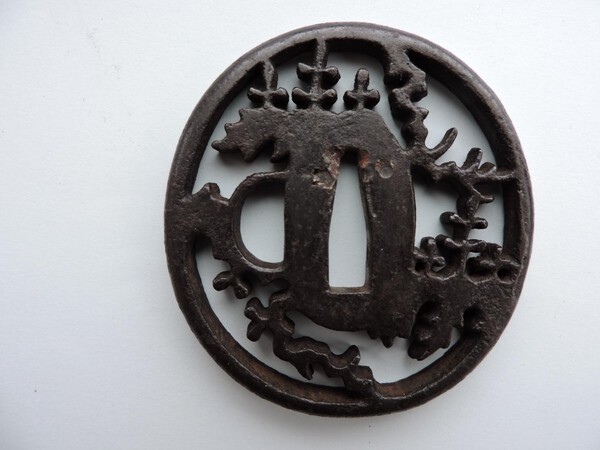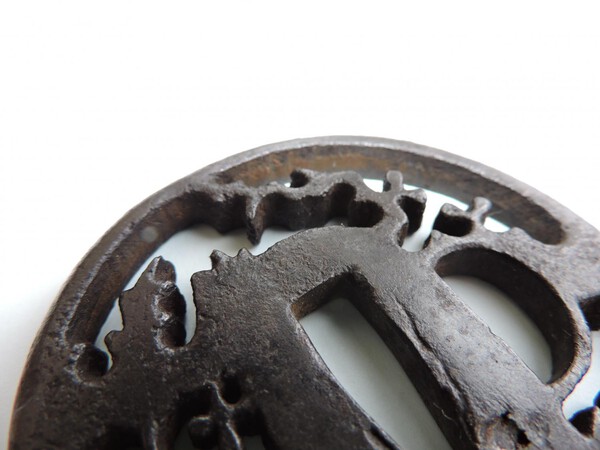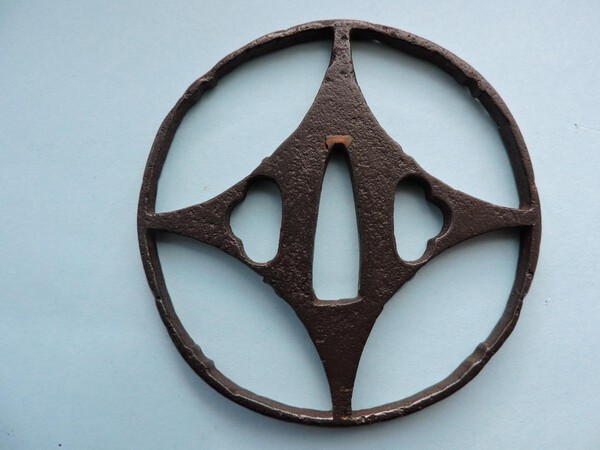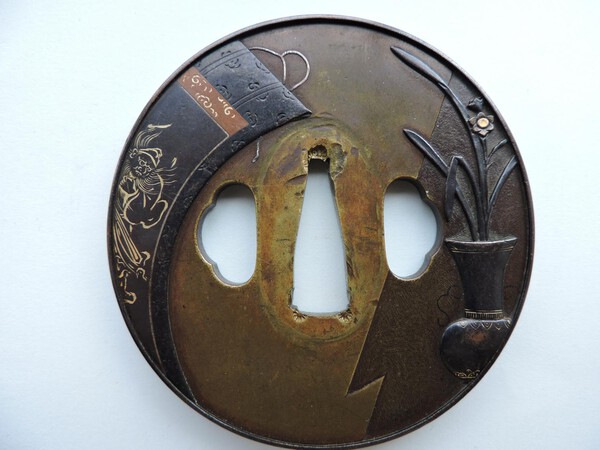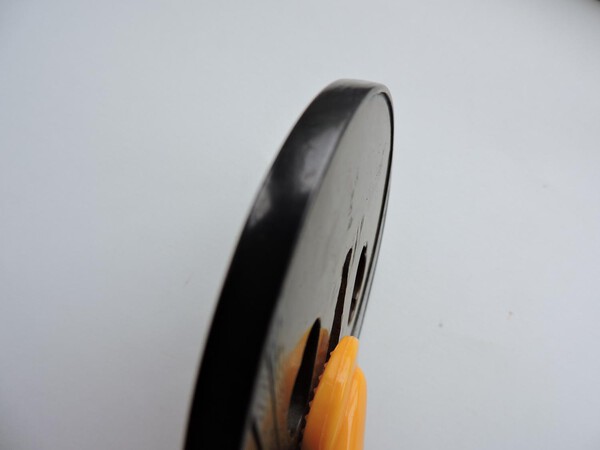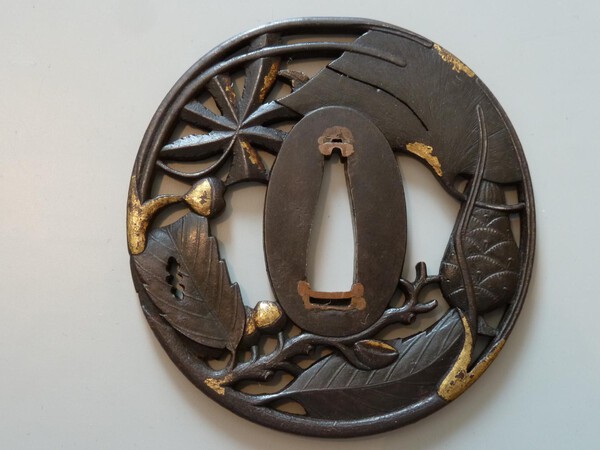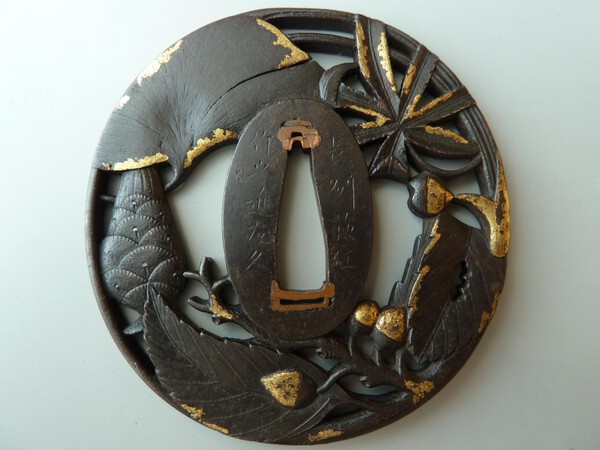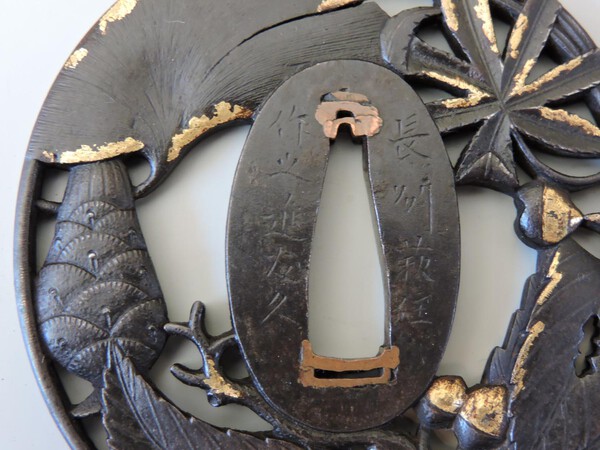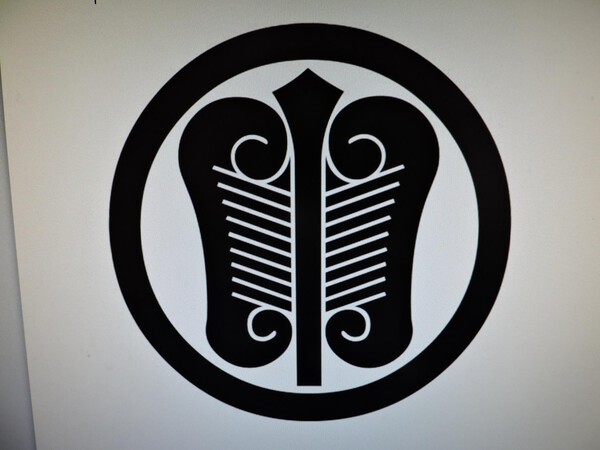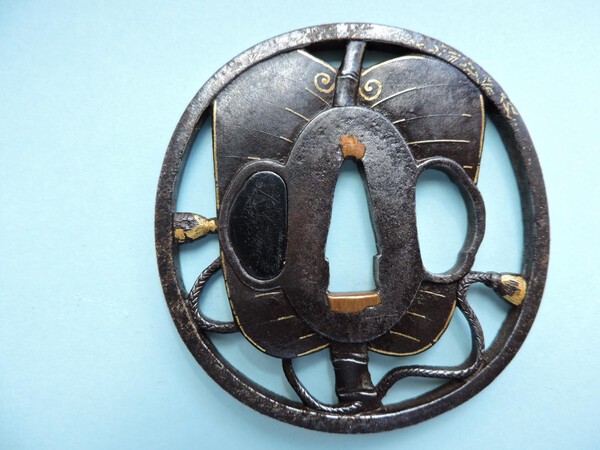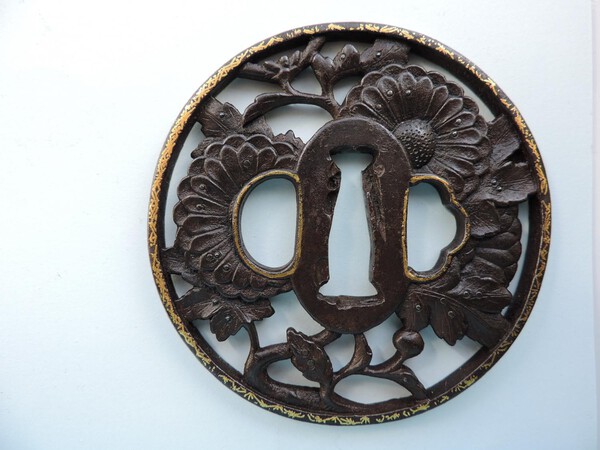
JohnTo
Gold Tier-
Posts
275 -
Joined
-
Last visited
Content Type
Profiles
Forums
Events
Store
Downloads
Gallery
Everything posted by JohnTo
-
Ruben, Old Pec' and tsuba are a great combination. I forgot to add a special thanks for the info regarding the unusual 'fu' in Efu. Alway good to learn something new. Best wishes, John
-
thanks Ruben, Steve. Ruben, 'Enjoy?' Don't worry I will. Its Friday afternoon and I have a pint of Old Peculiar waiting for me, which will help me hear the iron of this (and other tsuba) speaking to me. Best regards, John
-
The good thing about finding a signature of a minor artist on a piece of kodugu is that it is probably genuine. As the fame of the artist increases, so do the number of copies, fakes, homages and utsushi. I have a few iron Nobuie and Kaneie tsuba with passable signatures, but look as if they were made yesterday! The tsuba that I am presenting today for comment is from a bag of 19 loose tsuba, one of about 100 items that represented the remnants of the stock of the a Cape Town Oriental art dealer who died about 30 years ago. The items had remained in boxes until a recent auction. This oval shibuichi tsuba is decorated with a shippo (七宝, literally seven treasures) design, and referred to as a shippo tsunagi (shippo chain) when the inner and outer circles are interlinked, as this example. The symbol is found in ancient Egypt as well as Asia and is at least 3,500 years old and embodies a wish for family happiness and financial success. The design is finely cut with smooth even lines with the major open areas between the circles all cut to the same depth. The evenness of the cutting is so skilful that it looks as if the pattern were made by a machine, rather than by hand. The tsuba has a single kodzuka hitsu and both the size and overall design indicates that it was made for a wakizashi rather than a katana. There appears to be some wear on the seppa dai, but the nagako ana looks pristine as this tsuba was probably tailor made for the sword and thus did not require seki gane or punch closure of the nagako ana to obtain a precise fit. The tsuba bears the signature of Goto Mitsunobu/Mitsutoshi (後藤光寿) with a kakihan. According to some web pages, Fukushi reads the signature as Mitsunobu and the Toso Kodogu Koza says that although the kanji are commonly read as Mitsutoshi, Goto documents list the artist as Mitsunobu, with furigana reading aides by his name. As the Goto family read his name as Mitsunobu, it would seem that Mitsutoshi may be a modern mistake which has been repeated enough as to cause confusion. Goto Mitsunobu was possibly the third son of Senjo and adopted by Renjo (10th generation master of Goto Shirobei line of family) after the death of Renjo’s son, Mitsuyoshi, aged 25. Mitsunobu married Renjo’s daughter (probably a good career move) and became head of the Goto school aged 34. Mitsunobu became Tsujo (11th generation master, 1663-1721) and lived in Edo. The Ashmolean Museum in Oxford has a virtually identical tsuba to this in the AH Church Collection (Accession number EAX. 10899 with collectors number 1158, see pic). Some of the detail (especially the signature) is difficult to see in the Church example, but the distribution of the circles is the same, as is the placing of the signature. Only the karahana (four pettalled flowers in the centre of the circles) look slightly different, and are more like four dots in my example (a different punch was evidently used). As far as can be seen from the Church collection photo, the kakihan appears the same, but the rest of the signature lacks clarity for a critical comparison. However, the signature on the tsuba in the Church collection is probably misread and is listed as being signed by Goto Mitsunaga. It is also stated as probably not by Tsujo, the XIth master. The Boston Museum of Fine Arts has another identical example (accession number: 11.5433) signed ‘Goto Mitsutoshi’ (see pic). This has the same karahana, as the Church example, and the two look as if they could have been turned out together from a 3-D printer. The ‘Toshi/Nobu’ kanji differs from mine in that it appears stiffer and the lower half has a square rather than a single stroke. The three tsuba are so similar that I would say that they came from the same workshop and perhaps from the same hand (though probably not Tsujo’s). One source reports that 24 items by Tsujo have passed Juyo, so I suspect that there are more utsushi extant than genuine works. The difference in the second kanji of his name is interesting. Perhaps Tsujo was called Mitsutoshi and Mitsunobu, slightly changing the kanji when he changed his name. Unlikely, but I like to think outside the box. Whether genuine or fake I think that it is a skilfully made tsuba and I wish to treat it with care. Close examination of the piercings reveals some dirt and crud. What is the best way to remove this without affecting the patina? Washing with a water based detergent, spraying with an aerosol electrical contact cleaner (alcohol based, no chlorinated material), or soak in white spirit to remove grease? Dimensions: Height: 7.05 cm, Width: 6.65 cm, Thickness (rim): 0.35 cm Thanks in advance for any help. John (just a guy making observations, asking questions, trying to learn)
-
I’m having trouble reading the last kanji of this signature, which I believe reads Efu ju Masa????. The last character just looks like a squiggle to me. This oval iron tsuba is unusual in that it is a flat plate and the decoration appears to have been made by etching. At first sight the brown patina of the iron appears to be bronze, but it is magnetic. The scenes on the front and back are similar and consist of a range of three mountains at the top, a woodland in the middle (with maybe a thatched hut) and a lake or riverbank at the bottom, one side with a man in a small boat, the other with figure looking over the water. Height: 7.1 cm; Width: 6.7 cm; Thickness (rim): 0.15 cm, Seppa Dai: 0.4 Any other information regarding the maker would be welcome. Best regards, John
-
The trouble with standard wood tsuba boxes are that they are quite large. I have about 10 and I'm short of storage space. I took delivery of 25 slimline tsuba boxes yesterday, cost less than 50p each. I do need to fit linings in them and have not quite worked out the best way of doing that, but as the topic is 'hot', I will probably cut out CD shaped liners and then cut out a profile of the tsuba. I thought that I should write now and share my initial experiences. My tsuba boxes look remarkably like CD jewel boxes, which is what they are (make sure you get the 10 mm wide ones and not the thin ones). I intend to put copies of my write ups of the tsuba in each case, just like the sleve notes of a music CD (I quickly printed out a rough version just to illustrate). Just knock out some of the central spines to hold the CD and the tsuba is held in place. And I already have a storage unit, just needed to through out some old CDs. OK, not as elegant as the wood boxes, but a lot cheaper! best regards, John
-
I really hadn’t given much thought to the kashira as, without the fuchi, it’s a bit like having just one sock; OK if you are a one legged man, but otherwise… I guess I will have to start searching Ebay. Christian, I’m not sure I understand what you mean by ‘definitely- NO Yagyu!’. If you read the original posting carefully you will note that I did say that I did not believe that it was Yagyu work; just based upon a Yagyu design. Sasano wrtites that Inaba Tsuryu published an illustrated album of 110 Yagyu designs and that Imaizumi Gennai compiled an album of 163 Yagyu designs. Unfortunately, I do not have reference to these works, but perhaps you did and failed to find this particular design? Yagyu designs were apparently used by tsubako from other schools including the Ono, Owari and Bushu, right up to the haitto-rei, according to my sources. That does not mean they were copied skilfully or with all the characteristics associated with Yagyu work. I still propose that this tsuba was based upon a Yagyu design and to support my supposition I attach a couple of pics of Yagyu tsuba that I found on this site, together with a NTHK certificated Ono tsuba that Grey Doffin had for sale. The Ono tsuba was stated as being based on a Yagyu design and is effectively 2-D like mine, i.e. flat and not sculpted. Both the Yagyu tsuba have waves and the mysterious circular hole in the design, like mine, which I still would like to know what they represent. I rest my case for the defence. As a relative newby to tsuba collecting I like to glean as much info as I can for each new addition to my collection and appreciate constructive criticism to my observations. Best regards, John (just a guy making observations, asking questions, trying to learn)
-
When I bought this tsuba it had a copper crayfish kashira riveted to the seppa dai (see pic). Luckily it was only lightly attached and not hard soldered on and I was able to easily remove it. Possibly it was used as a paper weight and the kashira was used to pick it up. The tsuba itself was in good condition apart from some red surface rust (I understand it had been stored for 30 years in a loft or basement0, which I removed with WD-40, cotton buds and wooden cocktail sticks. The iron has a matt black patina and appears covered with speckles, see pic of rim, indicating that the iron was forged from a mixture of irons and not fully homogenized to a lifeless plate. The tsuba is what I call ‘2-D sukashi’, in that the plate is flat and the design cut vertically through the iron with no attempt to round the edges or sink the body below the rim. The design appears to be a tomoe (comma) with a long tapering tail, which forms the rim. Waves are shown rising out of the rim, possibly crashing against the body of the tomoe (duplicating as a boulder?). Overall, the design seems to shout Yagyu, but waves in Yagyu designs are generally rounded at the edges giving a softer 3-D look and I understand that layering of the iron can also be seen (I can’t see any here). I would therefore think that this is a copy of a Yagyu design. I read that Ono and others copied Yagyu designs, but the examples that I have seen illustrated also have some 3-D characteristics. I have also noticed in some illustrations of Yagyu tsuba the presence of a small open circle in the design, which this tsuba has in the top left corner between the wave and the rim. Any idea of the significance of these? The presence of two small (1 mm diameter) holes at each end of the seppa dai have, no doubt, reduced the value of this tsuba (not that I intend to sell it). But by how much when one considers the heaving bashing with hammer and chisel around the nagako ana that it received in antiquity? So there we have it, a sukashi tsuba with what I think is a Yagyu look. Comments and opinions would be welcome. Height: 7.8 cm, Width: 7.7 cm, Thickness (rim): 0.45 cm Thanks John (just a guy making observations, asking questions, trying to learn)
-
Thanks Steven and Steve When I read the first reply I was a bit dubious of the first kanji being ‘yasu’ (安) as it looked nothing like my ‘yasu’. Searching on the web I found a couple of tsuba (pics attached) which were sold at Bonhams. Tsuba 1: Nara Yasuchika II is a similar style to mine, iron carved with chidori, but the signature is安親.Lot 1086, Arts of the Samurai, 08 Oct 2013, New York. Tsuba 2: A shibuichi tsuba with an with an elephant and sparrows in takabori, shishiai-bori, and copper and gold takazogan. Apparently the tsuba was made to deliberately look worn with age. The signature on this is康親 in a seal, with the two kanji looking like mine. The tsuba was actually catalogued as Shonai, after Yasuchika. Lot 306, Arts of the Samurai, 30 Oct 2017, New York. So I guess that’s it. Yasuchika. Which just leaves the question ‘Is it genuine?’ Always a problem Thanks again, help from guys like you is what makes NMB so great. John (just a guy making observations, asking questions, trying to learn)
-
Hi guys, Can you help with the gold inlaid signature on this iron tsuba? The signature is not in a seal, but the cursive (correct term?) style of writing has me lost with the first character. It is a bit like Kaze/fu but I don’t think so. The second kanji appears to be ‘chika’ A description of the tsuba is as follows, and my best guess as to school would be Kaneie. A maru gata iron tsuba with a black patina, slightly dished with rounded edges and the usual pair of kogai and kodzuka hitsu (the kodzuka hitsu is lined on the straight edge with apiece of shakudo). The nagako ana is rather wide and is fitted with copper seki gane to top and bottom. The tsuba has a simple design, carved in shallow relief (sukidashi takabori) and depicts a peasant in a straw cloak and hat, with a hoe over his shoulder, crossing a low bridge on stilts. Above the man is a flock of 15 birds (geese?) flying in squally weather, as depicted by driving rain and bamboo bending in the wind (a similar scene on birds, wind and bamboo is shown on the reverse. The design is plain and without embellishment with, for example, gold nunome and yet the signature is inlaid with gold, even though it would be hidden by the seppa. The cursive script makes it difficult to read, the first character is unknown, but the second appears to be ‘chika’. Height: 7.8 cm, Width: 7.6 cm, Thickness (rim): 0.4 cm Thanks John (just a guy making observations, asking questions, trying to learn)
-
Luca, I've been away from the NNB for a while and have just discoved your Kaga pdf. Excellent piece of work with kanji in the texts and references at the end. Published info don't get better than that. Thanks for all your work and making it available to all. I was interested to see the tsuba in B.5, C with a fuchi/kashira attached to it, in the Boston museum. I have just bought a sukashi tsuba with a kashira rivited to the seppa dai and was thinking to myself 'What sort of idiot would do that'. Guess there were at least two. great work, thanks again, John
-
I bought a tsuba with a similar broad rim and flat profile that came with an ‘origami’ (not shown in auction), that turned out to be a NTKK kanteisho. The origami did not arrive until about a week later, during which time I could not assign a school or maker to it. In my limited experience the unusually wide rim made it difficult to assign. NTKK says it is Unshu Tani Toyochika. My inventory notes are below and pics for comparison are attached. Anyone got a better translation for the description of the design, Tan-satu-to, a half/short (tan) counter of books (satsu) that is open/transparent (to)? This large tsuba is of round flat sukashi form with what appears to be three carpenter’s squares cut out of a flat iron plate. The kanteisho describes them as tan-satsu-to (literally. Short-counters for books-transparent) The width of the rim is unusually wide, indicating that this is not the work of most of the sukashi schools such as the Kyo, Akasaka, or Owari. The tsuba is unsigned, but came with a box containing a label, in Japanese, attributing the tsuba to ‘Unshu Tani Toyochika’, i.e. Toyachika of the Tani school in the province of Unshu. The lot was also accompanied by a NTKK (Nihon Tosogu Kenkyu Kai) origami that arrived a week later confirming this attribution (see below). The Tani school was established in the Izumo no Kuni by Jirosuke Toyochika (working in the Meiwa period; 1764-72) and his son Toyoshige (working in the Kansei era; 1789-1801). There is also some gold nunome which is mostly worn away. The translation of part of the NTKK kanteisho, reading columns from right to left, is as follows: kantei-sho (鑑定書) - Appraisal No. tsuba (鐔) Tan-satsu-to (open half counter for books?), mumei (無銘), tetsu-ji (鉄地) – unsigned, iron XXXX XXXXXXXX ?Unshu Tani Toyochika Jidai (時代) Edo-chūkji (江戸中期) – time of production, mid-Edo period 厚mi - Dimentions Seppa Dai 4 mm, Mimi 3.5 mm Height: 82 mm Width: 82 mm Sunpyō (寸評) – Brief Review XXXX Shodai Unshu Tani Toyochika. Showa yori roku dai Toyotaka First generation Unshu Tani Toyochika until the Showa era sixth generation Toyotaka. Genji (1864) made daidai zokuki tomo ni sakaeru – Until Genji (1864) generations prospered together. Unshu o daihyo suru tsuba ko/ku-hon/moto saku- Representations of Unshu styles were made. Uki no tōri kantei-suru (右記の通り鑑定する) – The above is the summary of our appraisal. Heisei 21 year sixth month 13th day (June 13, 2009) Nihon Tōsōgu Kenkyū Kai (日本刀装具研究会) Best regards, John
-
I seem to have a penchant for buying cast iron tsuba via commisison bids at small auctions where the photos are not very good. Here is my latest. I would challenge Ford's supposition that these are modern, based upon the context in which I bought these. I think that all three came from mixed lots that contained authentic pieces, some from quite large groups of lots which I assumed were from deceased estates. So I think that they were acquired many years ago when tsuba were cheap and there was no demand fo modern fakes. Here is the description from my inventory. This sukashi tsuba appeared to be an Akasaka (or possibly Nishigaki or Higo) tsuba from the poor photograph on the auction website. However, upon receipt it was obvious that this is a cast iron copy of an Akasaka design, probably made in Japan in the 19thC as a cheap sword fitting for an impoverished owner. The tell tale signs of casting are the glossy patina, flaking of the surface around the rim and fine ridge line near the centre of the piercings for joins in the mould. There are also two circular marks either side of the top of the seppa dai, which look like welding spots. I would surmise that these had been done at a later date, possibly to affix the tsuba to something as decoration. See ##019 and ##024 for other examples of cast iron tsuba. Provenance: Canterbury Auctions, Wednesday 10th April 2018, Lot 594 Height: 7.0 cm Width: 6.6 cm Thickness: 0.65 cm rim Some bids are diamonds, some bids are dust/rust. Its good to admit ones failures on NMB, quite cathartic. All the best, John
-
Thanks Ford for the clarification. It is interesting to look at descriptions of 'sandy brown' alloy tsuba in various catalogues and books. One auctioneer will describe nearly all such items as brass, another as sentoku and another as shinchu. I guess it needs someone to publish a book on Japanese alloys. Then we have differing compositions of brass, anything from 5% to 40% zinc, sometimes with a dash of lead, etc. So to misquote Star Trek 'Its brass, John, but not as we know it' Looking forward to the book, thanks again for the comment, John
-
Here is the tsuba im my collection that i think embodies wabi sabi. i think that it is Kanayama and I've posted it before in more detail. The iron is roughly finished, looking heavily rusted, but its not. Spokes have been removed to leave the simplest of designs. In summary a natural looking piece of old iron with lots of imperfections that has a lonely, empty feel to it. Wabi sabi as far as I'm concerned, Best regards, John
-
Thanks for the replies. Pete, Bruno, Curran, Steven: Shonai Shoami. That is a branch of the Shoami that I am unfamiliar with. The few examples that I have found so far show a wide variety of styles, so I would not have attributed this tsuba to that school. There were a couple of examples of similar workmanship, so thanks for the info. Its what the NMB is for after all, sharing ideas and learning. Pete. I'm not sure that I agree with you saying that they are just punch marks. The bottom ones do not seem to have any significant effect on the size of the nagako ana. I think that they are more for decoration, as I have seen on other 19thC tsuba made for export and have never been on a sword. Nagoya mono tsuba (cheap copies of Mino Goto) have a characteristic pattern of 10 large punch marks in all the half dozen patterns I have seen (treasure ship, pagaoda, Ono no Komachi etc). See discussion on NMB a couple of months ago. Although large marks, they are all the same pattern and obviously not for resizing the nagako ana. I suspect that these flower punch marks were used in several workshops in Edo. Thanks again for the info everyone, best regards, John Just a guy trying to learn and sitting at his PC waiting for the postman to deliver his next treasure from Japan
-
I’ll ask the usual questions at the start, namely any ideas on the school and maker, plus any ideas about the theme of the design, which I have not seen before? This large maru gata tsuba appears to be made of brass (sentoku) or closely related alloy giving it a slight red-brown patina. The scene continues over both sides and depicts a hanging scroll falling off what I assume is a wooden, two legged easel (in shakudo?) with a tying ring at the top. There is also a shakudo vase with a golden flower and long tapering leaves (daffodil?). This vase is on a separate, slightly sunken, lightly hammered, chocolate brown area, separated from the main body by a zig-zag line, possibly to indicate a violent event, e.g. perhaps the scene has been disrupted by a sudden gust of wind. Like a good fitting toupee, I cannot detect the join between the sentoku and the chocolate brown area, so perhaps it is not inlay, but a change in patination. The tsuba is fitted with a shakudo fukurin and has a pair of kogai hitsu ana. Staining and slight damage around the nagako ana indicates that this tsuba was once mounted on a sword and was not just a piece made for presentation, or the 19thC export market. The loose hanging scroll depicts Shoki (the demon slayer) picked out in fine gold inlay on a charcoal grey background (representing a sheet of paper), which is framed in sentoku(?) and copper, all on a shakudo scroll. Even the end of the pole at the bottom of the scroll is tipped in silver. The vase is finely inlayed with gold and the flower (daffodil) is probably gold. Altogether, a finely crafted piece of work, but unsigned (not that signatures can be relied upon). I reckon that the tsuba was made about 1800, give or take 50 years maximum. There were lots of skilled kinko artisans around this time, many signed their works, but some did not. There maybe two clues as to the school. On the face of the tsuba there are three flower shaped punch marks, one at each bottom corner of the nagako ana and a double at the point. None is complete, but may be a ca. 14 petal chrysanthemums. They look like tagane mei (chisel name) rather than attempts to modify the shape. The other clue is the representation of the scroll, which wraps around the rim to appear on both faces of the tsuba. To judge from auction catalogues etc., continuing the design on both the front and back of mixed metal tsuba seems to be in vogue during the first half of the 19thC. One of the aspects that I love about collecting tsuba is figuring out the scene that they depict. At the time they were made, I expect that the themes would have been well known to the average Japanese, but many have now been forgotten. I spent a long time wondering why someone would want to portray a scroll being blown aside by a gust of wind. Then I watched a Japanese version of the 47 Ronin and think that I may have found the answer. The Ako Incident, in which the 47 Ronin avenged their lord’s death by killing Lord Kira took place on 30th January 1703. OK, that was winter, but an early daffodil could have been placed as a decoration indoors in a vase, as shown on the tsuba. The popular version of events has Lord Kira hiding in a charcoal store out in the back somewhere. I can’t imagine the main charcoal store being close to Kira’s bedroom and maybe the story was exaggerated to further blacken Kira’s name (sorry guys, could not resist that one). A different version has Kira being found in a secret courtyard behind his bedroom, hidden by a large scroll, that maybe held a small quantity of charcoal for the bedroom heating. Perhaps the design on the scroll (Shoki, killer of oni) represents Oishi Kuranosuke killer of Kira. I have found flower punch marks (literature examples) on tsuba by Hagiya Katsuhira (Mito school, ca. 1870), Ichijuken Teruaki (Kato school, ca 1860), Funada Ikken (Goto school, 1844), unsigned Mino Goto, unsigned Hamano school (19th C), Oishi Akichika (1854, Oishi Akichika making a tsuba alluding to Oishi Kuransuke, see above?, Nah, coincidence) and Kano Natsuo. So I guess flower punches were used by many of the tsuba artisans in the 19thC, which probably reflects fluidity between the artists and workshops, many of which were in Edo. I would imagine that artisans fashioned their own tools and that making flower punches was part of the training in one or more workshops. I gather that many of the 19thC kinko artist used designs supplied by other artists on paper and I believe this is why we see so many 19thC kinko tsuba with apparently unique designs; there were so many to choose from. To my aesthetics, it makes a welcome change from the same old Kinai dragons, aoi leaves, carp, etc. of the 18thC and similar repetitious designs of other schools. Unfortunately, many of these high quality kinko works are unsigned. Why was this? My best guess is that this tsuba was made about 1800 in one of the Edo workshops (Goto, Yokoya, Nara, Kono), but this is not based upon handling similar examples, so feel free to challenge. Height: 7.8 cm; Width: 7.65 cm; Thickness (rim): 0.55 cm; Weight: 168g Best regards, John (just a guy making observations, asking questions, trying to learn)
-
Thanks Bruno, Good to see another example of the basic pattern. Yours has a flatter profile and with the brass inlay I agree that makes it likely to be Heianjo. regards, John
-
Thanks for the replies. Geraint, you are probably right about the 'fukurin' and it is nunome (inlay attached by cross hatched grooves). Problem is that the exposed areas have slight corrosion and I can't definitely detect the anchor grooves. Opinion seems to remain with Echizen, though others had very similar styles. As I look in my cabinet of tsuba, this one definitely reflects the light more than my other black iron tsuba. I guess just a more careful attention to getting a smooth shiny surface finish rather than the quirk of some other scool. Best regards, John
-
Hopefully it is difficult for NMB members to differentiate between the leaves of cannabis and acer palmatum, both commonly have 7 serated sections to their leaves and are virtually identical when taken out of natural context, e.g. depicted on a tsuba. I'm told that the leaves can be told apart by the smell when burnt, but I have no experience of burning maple leaves. Besides, its difficult to burn an iron tsuba (not that I would want to). Just for you delectation I attach pics of a tsuba of mine which includes a beech tree branch with nuts, a single ginko leaf, a pine cone and a cannabis/maple leaf. As the others are woodland plants, I assume it to be maple. The description of the tsuba is: This iron sukashi tsuba depicts leaves and a pine cone carved in three dimensions and is highlighted in gold nunome zogan (hammering gold leaf into a criss-cross engraving). The tsuba is 'signed' Nagato (Choshu) Hagi Ju Sakunoshin Tomohisa, who was the first generation master of the Yazu (often pronounced Yaji) School and active in the Enpo (1673-81) and Jokyo (1684-88) periods. The translation of the signature is ‘Nagato Hagi Ju’: ‘Resident of Hagi in Nagato (Choshu) province’, ‘Sakunoshin Tomohisa’: ‘Tomohisa, personal name Sakunoshin’. Seven generations of artisans, all using the same kanji for Tomo as the first part of their names, are listed by Markus Sesko and were active until about 1850. I have seen other examples of this design, one signed Rakurakusai Tomosada, so I guess it was popular. Height: 7.5 cm, Width: 7.3 cm Thickness: 0.4 cm Best regards, John
-
Lovely tsuba, if I hold my breath long enough and turn purple, maybe my wife will let me buy it. Can't say if its genuine, but the NBTHK think so. I've seen several iron Goto tsuba come up in auctions. One I have found is Lot 167, Compton I, a late Goto school daisho, with NBTHK kicho for the dai and sho. They were made by Goto Ichijo (1791-1876) and signed Toki ni nanajugo raku Hakuo saku and Kaku hoku kyo Hakuo saku. According to Christies he signed Hakuo on iron tsuba because 'Even at this late perion the traditions of the Goto school were such that the master of the school could not use his official Goto names on an iron tsuba. This prohibition did not extend to accompanying documents and tomobako, where the formal signature was considered appropriate.' So maybe Goto Seijo broke the rules, or they had not been formalised when he was around (mid 1600s) Regards, John
-
the Notice board did not like the format of the maruni to uchiwa kamon, so I had to phtograph it. John
-
Hi guys This maru gata iron sukashi tsuba has a design of large gunbai (war fan) enclosed by a square profiled mimi. Dimensions: Height: 7.05 cm, Width: 6.75 cm, Thickness: 0.4 cm The tsuba is unsigned but I have tentatively attributed it to the Kinai Echizen school based upon the gently sculpted fan and chords in katachi bori (carving the design in the round into the surface of the iron plate), black patina and fine gold nunome inlay. The Echizen Kinai did not seem to be shy about signing their work, and as this is a design outside their usual production of dragons, aoi leaves and carp, I would have expected it to have been signed; if it was made by them. My alternative assignments are (Bizen) Shoami based upon mumei Echizen style tsuba I have seen, or possible Ono (guessing here). The tsuba has a pair of kogai hitsu, one of which is plugged with shakudo. I would date the tsuba a second half of the 18thC. But please challenge my attributions. There are several interesting features about this tsuba about which I seek info and comments, as follows: Gunbai (fan) design: The large gunbai that takes up most of the space seems to be an unusual design. I have only found illustrations of a couple of tsuba with large gunbai, although tsuba with small gunbai incorporated as part of the design are more common. The central stem of the gunbai is curved to the left, as are the vast majority of representations that I have seen and may therefore represent a kamon (variant of of Okudaira mon?), rather than a symbol of military authority. Additionally, the kara uchiwa (Chinese fan), also a symbol of authority and I believe was one of the items in the takarabune (treasure ship of the gods of good luck). I have found a kamon listed as ‘maruni to uchiwa’ (circle and fan?) very similar to the design on this tsuba, but without any clan attribution (see picture). Any information out there regarding gunbai/uchiwa fans and as to why the central stem is often shown curved whereas real gunbai stems are straight? Also what is the difference between a gunbai and uchiwa fan? Patina: One of the kantei points that I have used in attributing this tsuba to Kinai is the black patina, rather than the russet brown of many other schools. However, the patina on this tsuba is glossy and resembles shakudo, whereas the patina on the couple of other Kinai tsuba that I have is dull. The patina appears thin and has been rubbed off much of the seppa dai, exposing the shiny iron underneath. If it was not for this evidence of wear I would have been tempted to say that the tsuba had been repatinated by a gunsmith, as it looks like the black finish of modern gun. Perhaps the original owner wanted an iron tsuba to look like shakudo, in accordance with the Edo court requirements. Mimi: The mimi bares traces of a silver alloy fukurin, which has mostly worn away and exposed the underlying iron, resulting in slight pitting and corrosion. I’m not sure if the coating is substantial enough to be called a fukurin as it appears to have been rather thin. The remaining metal has a white shiny appearance, like silver, but I hesitate to call it silver as I would expect silver to be black after all this time. I have tsuba with ‘black silver’ and ‘silver silver’ on the same piece, so I assume that ‘silver silver’ is actually an alloy that does not darken with age (Over to you Ford?) The thin fukurin was probably the cause of the corrosion around the mimi. I imagine that once the fukurin became damaged, and the underlying iron was exposed, a galvanic cell (battery) would have been created between the iron and silver in which the iron (anode) corroded (rusted) once the tsuba became wet (rain, sweat). The mimi also bears traces of pine needle shaped gold nunome. Best regards, John (just a guy making observations, asking questions, trying to learn)
-
I wonder if odd shaped nagako ana was to fit around the spur on a jitte (sword breaker) or hachiwari (helmet breaker). I know that jitte don't normally have tsuba, but some Meiji policeman might have quickly added a crude tsuba. Regards, John
-
Nice tsuba. The seppa dai looks namban style but the main part looks like Bushu/Efu (Edo) carving. An interesting feature is the numerous tiny ‘silver nail heads’. I’ve got these on a mumei tsuba (see pics) of chrysanthemums which I attributed to Bushu, Shoami or Choshu schools. Choshu was least favourite as I believe they were not great on gold nunome around the mimi. Aoi-Art has a similar style tsuba (F16179) to mine for sale with silver nail heads and a NBTHK Hozon attributed to the Kyo-Shoami school. I don’t know how common ‘silver nail heads’ are as a decoration, or if they can be used as a kantei point. But that’s my best guess, a mixture of styles but carving in the round plus silver nail heads gives Shoami. Best regards, John (just a guy making observations, asking questions, trying to learn)
-
The shiirimono issued deepens with more examples being shown above, some with NBTHK papers. I have found three in the Compton Collection part III catalogue (lots 31, 32 and 33), where they are described as Nagoya-Mono tsuba and made of nigurome plate. The footnote to lot 32 says ‘This style of tsuba was made to resemble the work of the Mino Goto school. The demand for Goto style work was so great in the mid-Edo period that the Goto artists could not keep up with demand, so various artists in Nagoya helped supply pieces in the Goto style.’ The three pieces were dated as 1700-1750 and sold for $440 to $880 each; not cheap! Unfortunately neither the Compton catalogue nor the Nihon To Koza VI glossaries define what the alloy nigurome is. The Wikipidia enlightens us with ‘shakudo…entailed the heating of copper, addition of fine gold, and some addition of shirome, a by-product of copper production containing iron, arsenic and other elements. In the Edo period, it appears that the process may have used nigurome rather than copper; nigurome being itself a pre-made mix of copper and shirome. The resulting alloy was then allowed to rest in ingot moulds in heated water, before being shaped, and annealed at around 650 C. In cooled form, the metal was then surface-finished using the niiro process. The modern process tends to omit the shirome, working with copper and gold, and other additives directly if needed.’ For a detailed article of shakudo and nigurome see reference 3 in the Wikipidia article, by Oguchi (Öguchi, H. Gold Bull (1983) 16: 125. https://doi.org/10.1007/BF03214636). Oguchi states that the making of shakudo was a complex process and a closely kept secret within the Goto family. For example, using the wrong sort of charcoal in the furnace resulted in shakudo that took on a grey, rather than black patination. So it would seem likely that the Nagoya tsubako used nigurome, an alloy without gold, as they were unable to make good quality shakudo (A project for Ford and his buddy with the XRF analyser?). In my mind it explains why the seppa dai of most of Nagoya-mono tsuba that I have seen (mainly photos) are bronze coloured rather than blue-black. While I can accept that these tsuba were probably made for poor samurai who could not afford the genuine Goto products, I’m still left with the problem of the nagako ana. Many of the photos that I have seen show the characteristic 10 punch marks and the few that I have handled show no signs of filing and scraping as a result of fitting to individual swords. Maybe they were made for mass produced blades that had identical nagako (unlikely). Perhaps the tsuba were fitted by packing the nakago ana with a soft material (paper?) and also used a soft material for the seppa that did not scratch the tsuba. Although I have seen no supporting evidence, I would not be surprised if apprentices from the Goto school were shipped off to Nagoya to produce these tsuba as part of their training. Maybe the Goto family owned the Nagoya ‘factories’. After all, it would be better economics to have a trainee earning money making inferior quality tsuba for someone else, but honing their skills before being allowed in the Goto workshops. It would also explain why some of these tsuba have NBTHK papers. From now on I shall be referring to these tsuba as Nagoya-mono, as it sounds a lot better than ‘off-the self’ (shiirimono). I no longer consider them to be fakes, just tsuba produced by workshops that were inferior to the great Goto artists of the time. One thing still concerns me. A newbe tsuba collector like myself has been able to find out a lot of information about these tsuba in a short time. Established dealers, with far more knowledge than I, often seem to be implying that these are Mino/Goto works. As someone who has used the Japanese dealers’ websites to improve my knowledge of tsuba, I shall exercise more caution when reading descriptions. I recall a zen monk who would look in the mirror each day and have a conversation with himself along the lines of ‘O monk’ ‘Yes sir?’ ’Don’t be fooled’ ’No sir, no sir’. Best regards, John (just a guy making observations, asking questions, trying to learn)


